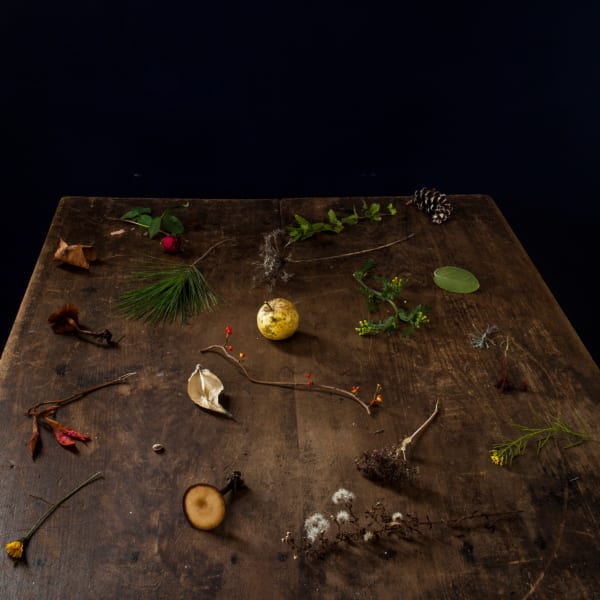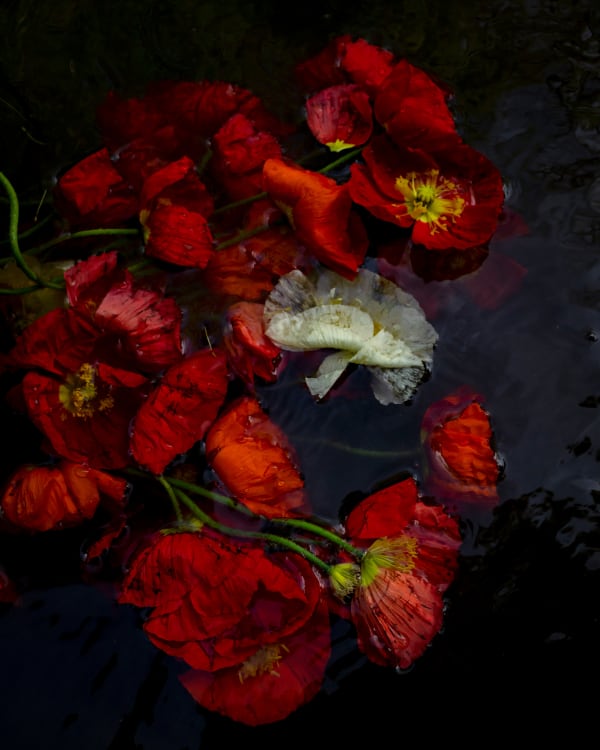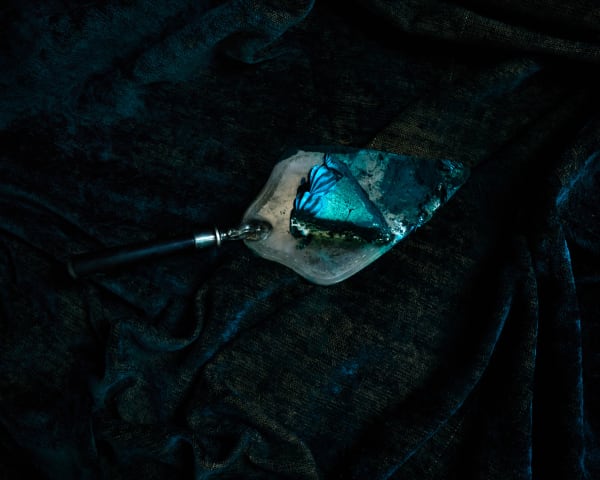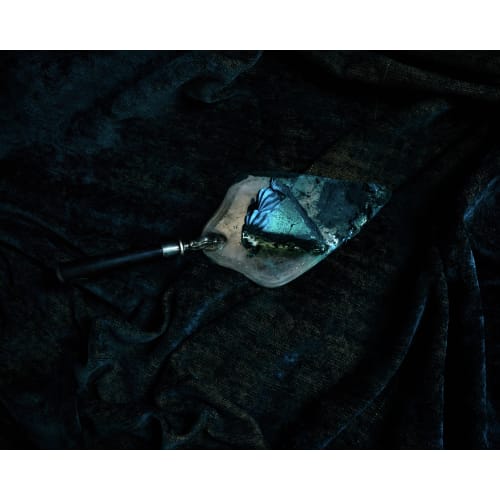Cig Harvey British, b. 1973
-
 Fall Table, Rockport, Maine, 2013.
Fall Table, Rockport, Maine, 2013. -
 Emerald Coat with Dahlia Petal, Union, Maine, 2019.
Emerald Coat with Dahlia Petal, Union, Maine, 2019. -
 Early Stardrift, Rockport, Maine, 2020.
Early Stardrift, Rockport, Maine, 2020. -
 Poppies (Sinking), Rockport, Maine, 2020.
Poppies (Sinking), Rockport, Maine, 2020. -
 The Compost Heap, Camden, Maine, 2020.
The Compost Heap, Camden, Maine, 2020. -
 Legs, Rockport, 2021.
Legs, Rockport, 2021. -
 Night Garden, Eagle Island, Maine, 2021.
Night Garden, Eagle Island, Maine, 2021. -
 Scout in the Apple Orchard, Rockport, Maine, 2021.
Scout in the Apple Orchard, Rockport, Maine, 2021. -
 Rhododendrons /Scout), Camden, 2022.
Rhododendrons /Scout), Camden, 2022. -
 Gold Road, Candem, 2023.
Gold Road, Candem, 2023. -
 Slice of Cake, Rockport, Maine, 2023.
Slice of Cake, Rockport, Maine, 2023. -
 The Cake That Fell from the Sky, Rockport, Maine, 2023.
The Cake That Fell from the Sky, Rockport, Maine, 2023. -
 January Swim, Rockport, 2023.
January Swim, Rockport, 2023. -
 Three Apricots (Wet), 2023.
Three Apricots (Wet), 2023. -
 Hawthorn Blossoms & Camelias, Devon, England, 2024.
Hawthorn Blossoms & Camelias, Devon, England, 2024. -
 This one is called Winged Kelp and RockWeed, Elizabeth,, 2025.
This one is called Winged Kelp and RockWeed, Elizabeth,, 2025. -
 Flowers, When We have No Words, (White Peonies) , 2025.
Flowers, When We have No Words, (White Peonies) , 2025.
Cig Harvey stands as one of contemporary photography's most distinctive voices, seamlessly blending large-format color photography with creative non-fiction to explore the profound question of what it means to feel and experience life with all senses.
Born Sara Harvey in 1973 in the rural countryside of Devon, Southwest England, she has spent the past two decades establishing herself as a photographer whose work reveals "the mysticism in the mundane" and has been compared to the surreal imagery of René Magritte.
Currently residing in a Maine farmhouse with her husband and daughter, Harvey's artistic practice is deeply rooted in the natural world and devoted to elevating everyday experiences into profound visual narratives. Her work occupies a unique niche in the photography world, appealing to broad audiences through her fearless engagement with beauty and her ability to transform ordinary moments into extraordinary revelations about human experience.
Early Life and Formative Years
Cig Harvey's journey into photography began in the deep valleys of Devon in the United Kingdom, where she grew up surrounded by the dramatic landscapes of the English countryside. Her early exposure to photography came through an unexpected source: the photo portfolios published in The Independent newspaper's Sunday editions, which sparked her initial interest in the medium. This early fascination quickly developed into a serious commitment when, at the remarkably young age of thirteen, Harvey began working in a community darkroom. This early hands-on experience with the photographic process would prove formative, establishing both her technical foundation and her deep connection to the craft of image-making.
The rural environment of her childhood would later become a crucial influence on her artistic vision, instilling in her an acute awareness of natural cycles, seasonal changes, and the subtle magic found in everyday rural life. Her upbringing in Devon's moorlands provided her with an intimate understanding of the relationship between humans and the natural world, a theme that would become central to her mature work. After completing her early education in England, Harvey ventured beyond her homeland, spending formative years living in Barcelona and Bermuda before making the pivotal decision to pursue formal artistic education in the United States.
Education and Early Career Development
In 1999, Harvey crossed the Atlantic to pursue her Master of Fine Arts degree at Maine Media College, a decision that would prove transformative both personally and artistically. This educational experience in Maine not only provided her with advanced technical skills and conceptual frameworks but also introduced her to the landscape and community that would become her permanent home. The rugged coastline, dense forests, and seasonal rhythms of Maine resonated deeply with her aesthetic sensibilities developed during her Devon childhood.
Following her graduation, Harvey embarked on her professional career as an assistant professor at the Art Institute of Boston at Lesley University, where she taught for ten years. This academic position allowed her to develop her pedagogical skills while continuing to evolve her artistic practice.
Artistic Philosophy and Creative Practice
Harvey's artistic approach is fundamentally centered on the exploration of sensory experience and emotional resonance. Her work consistently seeks to answer the profound question of "what it is to feel," using both images and language to create rich, implied narratives that elevate ordinary moments into extraordinary revelations. She describes her mission succinctly: "I am interested in the magic of everyday life," explaining that her pictures communicate that "time is the only currency." This philosophy drives her to capture what she calls "the fleeting magic found in the mundane," transforming seemingly trivial moments into images rich with color, light, and beauty.
Her artistic practice is deeply influenced by magical realism, and in discussing her work, Harvey has stated, "I am very interested in finding magic in the real world and photography reminds me that this world is amazing." This approach manifests in her distinctive visual style, which combines documentary observation with surreal, dreamlike qualities. Her photographs often feature vibrant, saturated colors and are characterized by their ability to make viewers pause and reconsider their relationship with the everyday world around them. Living in a farmhouse surrounded by Maine's natural beauty has made her particularly alert to the passing of seasons and the subtle transformations that occur in rural life.
Literary Integration and Multimedia Approach
One of Harvey's most distinctive characteristics as an artist is her seamless integration of photography with creative writing and poetry. This multimedia approach sets her apart from many contemporary photographers and reflects her belief that images and words can work together to create more profound emotional and sensory experiences. Her practice of combining large-format color photography with poetry and prose creates what she describes as explorations of "sensory experiences" that seek to "elevate the everyday."
This integration is particularly evident in her artist books, which function as complete artistic statements rather than simple collections of photographs. Her approach to book-making involves careful consideration of how text and image interact to create meaning, with her written work often taking the form of brief vignettes, personal recollections, and poetic observations that complement and expand upon her photographic narratives. This practice demonstrates her understanding of photography not just as a visual medium but as one component of a larger artistic ecosystem that can include multiple forms of expression.
Publication History and Book Projects
Harvey's commitment to the book form as an artistic medium has resulted in an impressive publication record that spans over a decade. Her first major publication, You Look At Me Like An Emergency, was released in 2012 and quickly sold out, establishing her as a significant voice in contemporary photography book publishing. This debut was notable not only for its commercial success but also for its artistic achievement, leading to her first solo museum exhibition at the Stenersen Museum in Oslo, Norway, in conjunction with the book's release.
Her second monograph, Gardening at Night, followed in 2015. This work continued her exploration of the intersection between the natural world and human experience, with Harvey citing magical realism as a primary influence. The book's title and imagery reflect her ongoing fascination with the liminal spaces between day and night, consciousness and dream, reality and imagination. Her third solo publication, You an Orchestra You a Bomb, released in 2017, marked a significant evolution in her artistic approach. This work was deeply influenced by Harvey's near-death experience in a car accident, which prompted her to adopt a more documentary style and explore what she describes as "the idea of the gasp and awe."
Her 2021 publication Blue Violet represents perhaps her greatest commercial and critical success to date. The book has gone through five printings, indicating both popular appeal and sustained interest in her work. Most recently, her 2022 publication Eat Flowers won the Fine Press Book Association's Judge's Choice Award for Best Book in Show at the Manhattan Fine Press Book Fair, cementing her reputation as a master of the photography book form.
Recent Work and Current Projects
Harvey's latest and most ambitious project, Emerald Drifters, was published in March 2025, representing four years of sustained creative work. This 224-page volume contains 97 photographs, 30 vignettes, and nine watercolor illustrations by Harvey herself, demonstrating her continued expansion into multiple artistic media. The book also features an essay by the acclaimed poet Ocean Vuong, who writes that in Harvey's hands, the concept of beauty "becomes the vehicle for self-knowledge." Vuong's contribution adds literary gravitas to the project and reflects Harvey's ability to attract collaboration from significant figures in contemporary literature.
Emerald Drifters represents what Harvey describes as "small increments of creativity, day by day, for four years, to make a book of heartbreaks and pleasures," emphasizing her commitment to sustained artistic practice and her belief that "a little can turn into a lot." The work continues her exploration of the intersection between personal experience and universal themes, featuring imagery that includes cakes, fruit, fish, flowers, and the natural world, with human presence suggested through mossy highways, dewy country houses, and faceless female figures.
Collections and Institutional Recognition
Harvey's photographs and books are held in the permanent collections of major museums and institutions worldwide, reflecting both the artistic merit of her work and its appeal to institutional collectors. Her work is represented in the collections of The Metropolitan Museum of Art, The Library of Congress, the Museum of Fine Arts in Boston and Houston, the Philadelphia Museum of Art, Yale University, the Farnsworth Art Museum, and the International Museum of Photography and Film at the George Eastman House. The JPMorgan Chase Art Collection also includes examples of her work, indicating corporate recognition of her artistic significance.
This broad institutional recognition reflects not only the quality of Harvey's work but also its accessibility and appeal to diverse audiences. The inclusion of her work in university collections suggests its educational value and its importance for future generations of artists and scholars. The presence of her books in library collections indicates recognition of her contribution to the medium of the photography book and the literary aspects of her practice.
Awards and Recognition
Throughout her career, Harvey has received numerous awards and recognition that highlight her contributions to contemporary photography. She was awarded the prestigious Prix Virginia Laureate in France in 2018, recognizing her international significance. The Farnsworth Art Museum honored her with their Maine in America Award in 2021, acknowledging both her artistic achievement and her connection to the state of Maine. In 2023, Maine Media presented Harvey with their Visionary Award in recognition of their 50th anniversary, with institution president Michael Mansfield stating, "She is a profoundly inspirational photographer and artist, and has ignited so many conversations here around pictures and words, and the sensations of human expression."
Harvey has been nominated for several other prestigious awards, including the John Gutmann Fellowship, the Santa Fe Prize, and the Prix Pictet. She has also been a finalist for the BMW Prize, the Estee Lauder Collection, the Karl Lagerfeld Collection at Paris Photo, the Clarence John Laughlin Award, and the Taylor Wessing Photographic Portrait Prize. Most recently, her 2022 book Eat Flowers won the Fine Press Book Association's Judge's Choice Award for Best Book in Show at the Manhattan Fine Press Book Fair, confirming her mastery of the book form.
Personal Philosophy and Impact
Harvey's approach to photography extends beyond mere aesthetic considerations to encompass a broader philosophy about art's role in enhancing human experience and empathy. She articulates this philosophy clearly: "If we feel more, I feel we will have more compassion. I use all of the formal devices that I have as an artist to ask, 'How can I get you to look? How can I get you to live more?'" This statement encapsulates her belief that art should serve not just as decoration or documentation but as a catalyst for increased awareness and emotional engagement with the world.
Her work consistently demonstrates a commitment to what she describes as "the gasp and awe," seeking to capture moments that elicit strong emotional responses whether through beauty or surprise. Harvey explains this concept by noting that "we gasp when something is beautiful, and we gasp when something is terrible. I'm searching for that push/pull in each image." This philosophy drives her to create work that doesn't simply document reality but transforms it into something that can provoke contemplation and emotional response.
Cig Harvey's biography reveals an artist who has successfully bridged multiple worlds: British and American, rural and sophisticated, photographic and literary, personal and universal. Her journey from a thirteen-year-old working in a Devon darkroom to an internationally recognized artist whose work graces major museum collections represents not just personal achievement but a significant contribution to contemporary photographic practice. Her ability to find profound meaning in everyday experiences, combined with her technical mastery and literary sensibility, has established her as a unique voice in contemporary art.


















